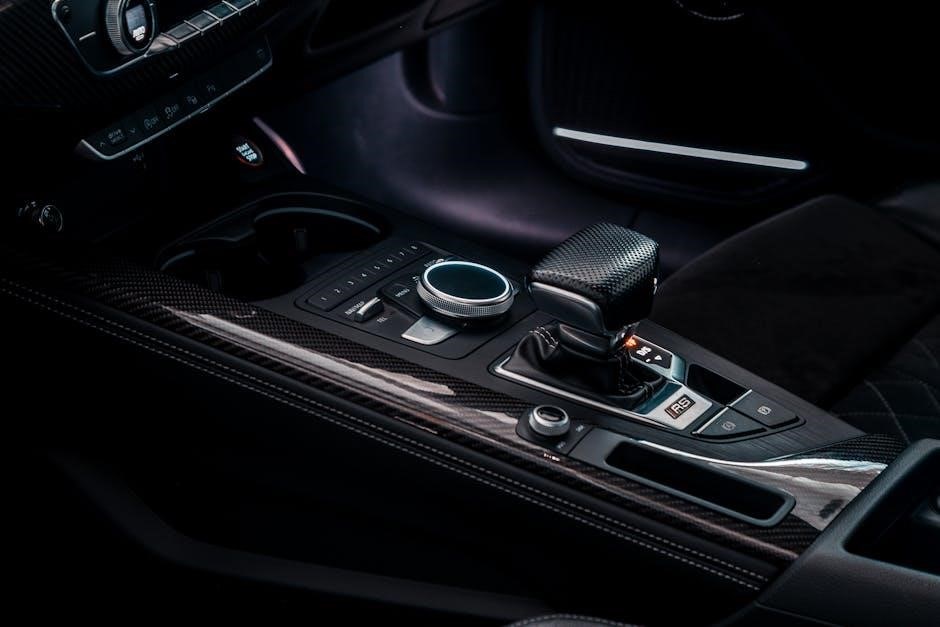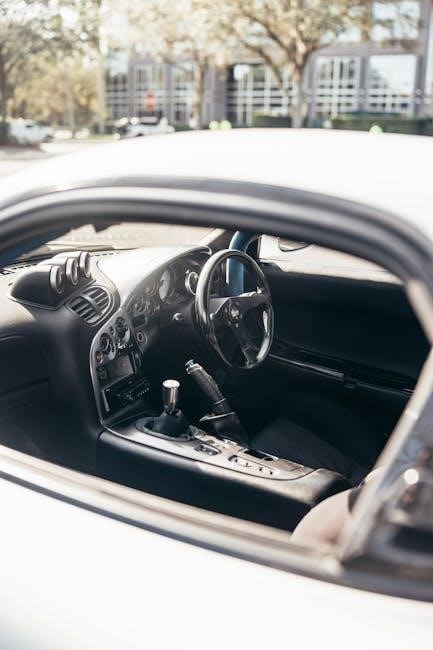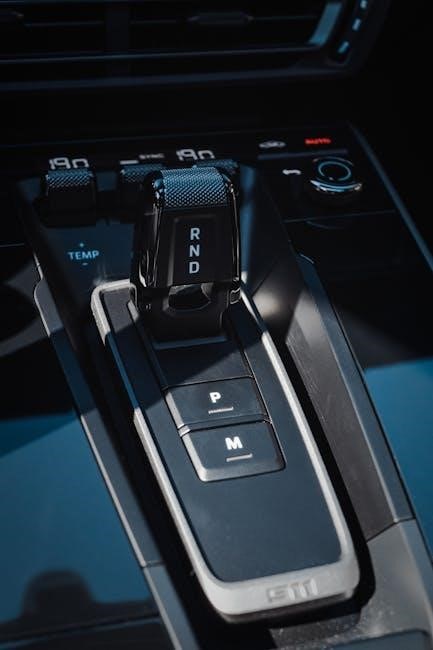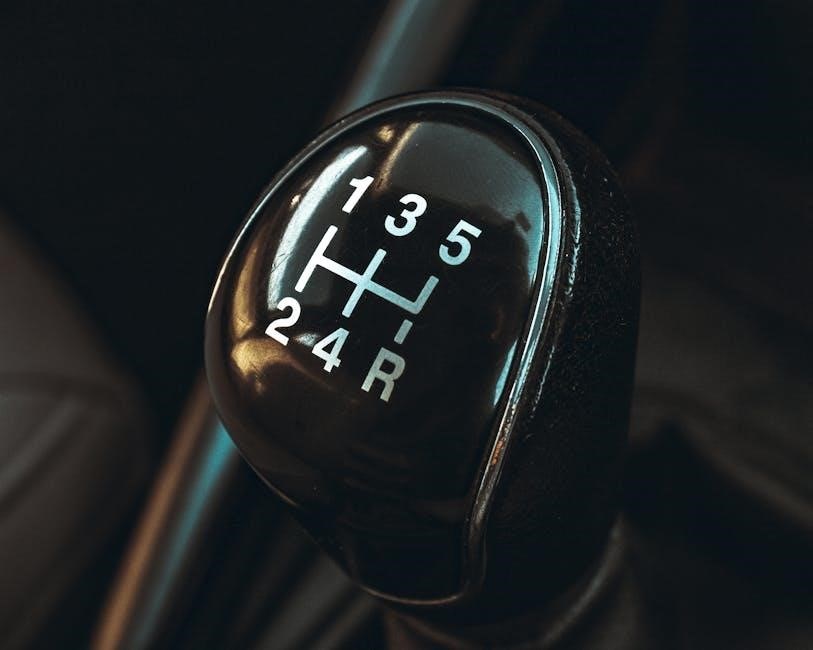
Converting a manual to an automatic gearbox is a complex process requiring mechanical expertise and specialized tools. It involves replacing the clutch and manual transmission system with an automatic unit, ensuring compatibility with the vehicle’s engine and drivetrain. This conversion is often pursued for smoother driving experiences or to accommodate specific engine swaps, such as the Coyote Mustang engine. While challenging and costly, it can offer improved drivability and convenience for certain applications.

Overview of the Conversion Process
Converting a manual gearbox to an automatic transmission involves several critical steps. First, selecting the appropriate automatic transmission that matches the vehicle’s engine specifications and drivetrain is essential. This requires compatibility checks to ensure smooth integration. Next, the clutch pedal and manual transmission system must be removed and replaced with an automatic unit, including a torque converter. The wiring harness and ECU may need upgrades to support the new transmission’s electronic controls. Additional modifications, such as transmission mounts and firewall adjustments, are often necessary. Hydraulic systems and sensors must also be installed to facilitate automatic gear shifting. The process is highly technical, requiring specialized tools and expertise. Proper calibration and testing are crucial to ensure optimal performance post-conversion. This complex procedure demands careful planning and execution to achieve a successful transformation.
Importance of Understanding Gearbox Differences
Understanding the differences between manual and automatic gearboxes is crucial for a successful conversion. Manual transmissions rely on driver input to shift gears, using a clutch and gearstick, while automatics employ hydraulic systems and torque converters to change gears automatically. These fundamental differences impact the entire drivetrain, including engine performance and fuel efficiency. Misalignment in compatibility can lead to mechanical failure or suboptimal performance. Recognizing these distinctions ensures that the chosen automatic transmission aligns with the vehicle’s specifications, preventing potential issues during and after conversion. It also helps in selecting the right tools and components, such as sensors and wiring harnesses, necessary for the process. This knowledge is vital for avoiding common pitfalls and ensuring a seamless transition from manual to automatic operation, enhancing both drivability and reliability.

Advantages and Disadvantages of Automatic Gearboxes
Automatic gearboxes offer ease of use, smoother acceleration, and reduced driver fatigue, especially in traffic. However, they are generally more expensive, heavier, and less fuel-efficient than manual transmissions.
Pros of Converting to an Automatic Transmission
Converting to an automatic transmission offers enhanced convenience and smoother driving experiences, especially in heavy traffic; It eliminates the need for manual gear shifting, reducing driver fatigue and providing effortless acceleration. Automatic transmissions are ideal for urban driving, as they simplify vehicle control and reduce the learning curve for new drivers. Additionally, automatic gearboxes can improve low-speed maneuverability and provide consistent performance in varying driving conditions. For vehicles with engine swaps, such as the Coyote Mustang engine, an automatic transmission often integrates seamlessly, offering a plug-and-play solution. Overall, the conversion enhances drivability and convenience, making it a worthwhile investment for those prioritizing ease of use and comfort behind the wheel.
Cons of Converting to an Automatic Transmission
Converting a manual to an automatic transmission can be a costly and complex process, requiring significant mechanical expertise. The conversion involves replacing the clutch, manual gearbox, and associated components, which can lead to high labor and parts costs. Additionally, automatic transmissions typically weigh more and may reduce fuel efficiency compared to manual counterparts. Some drivers may also notice a loss of control over gear shifts, which can be a drawback for performance-oriented driving. Furthermore, the conversion process may necessitate modifications to the vehicle’s wiring, mounts, and firewall, adding to the overall expense and complexity. For many, the financial and practical challenges outweigh the benefits, making it more practical to purchase a vehicle already equipped with an automatic transmission rather than undergoing a conversion.

Key Differences Between Manual and Automatic Transmissions
Manual transmissions require driver gear shifting for control and efficiency, while automatics shift automatically, offering convenience but often reducing fuel economy and driver engagement. Manuals are more engaging and efficient, while automatics provide smoother, easier driving experiences.
Manual Transmission Operation
A manual transmission operates through a driver-controlled clutch and gearshift, enabling manual selection of gear ratios. The clutch disconnects the engine from the transmission, allowing the driver to shift gears smoothly. This system relies on the driver’s coordination to press the clutch, select the appropriate gear, and release the clutch gradually. The gear ratios are designed to optimize engine power and speed for varying driving conditions. Manual transmissions provide precise control over the vehicle, making them popular among driving enthusiasts. They also typically offer better fuel efficiency compared to automatics, as the driver can optimize gear shifts for performance or economy. The direct connection between the engine and wheels enhances the driving experience, making manual transmissions a preferred choice for those who enjoy an engaging and hands-on driving style.
Automatic Transmission Operation
An automatic transmission operates by automatically changing gear ratios without driver intervention, using a torque converter to connect and disconnect engine power. Hydraulic pressure, controlled by sensors, engages clutches and brakes to manage planetary gear sets, ensuring smooth transitions. Electronic controls optimize shifting based on engine load and vehicle speed, providing seamless acceleration. Unlike manual transmissions, automatics eliminate the need for a clutch pedal, offering convenience and ease of use. The system also includes a lock-up torque converter for improved fuel efficiency at higher speeds. Automatic transmissions are designed to adapt to driving conditions, such as city traffic or highway cruising, by selecting the most appropriate gear. This hands-free operation makes driving less physically demanding, especially in stop-and-go situations, while maintaining performance and efficiency. The complexity of its hydraulic and electronic systems ensures a smooth, driver-friendly experience.
Comparison of Gear Shifting Mechanisms
Manual and automatic transmissions differ significantly in their gear-shifting mechanisms. Manual transmissions rely on a driver-operated clutch and gearshift, requiring manual engagement of gears. This process involves pressing the clutch pedal, selecting the appropriate gear with the shifter, and releasing the clutch smoothly to avoid stalling. In contrast, automatic transmissions use a torque converter and hydraulic controls to shift gears automatically, eliminating the need for driver input. The automatic system employs sensors to monitor engine speed and load, activating clutches and brakes within the planetary gear set to change gears seamlessly. While manual transmissions offer more control and driver engagement, automatics provide convenience and ease, especially in traffic-heavy conditions. Both systems aim to optimize power delivery, but their operational methods cater to different driving preferences and requirements. Understanding these mechanisms is crucial when considering a conversion from one type to the other. Each has its unique advantages and challenges.

Evaluating the Need for Conversion
Evaluating the need for manual to automatic gearbox conversion involves assessing driving habits, vehicle usage, and personal preferences. Automatics offer convenience, especially in traffic, while manuals provide control and fuel efficiency. Conversion suits those seeking smoother driving experiences or accommodating specific engine swaps, like the Coyote Mustang. Cost, complexity, and compatibility are key considerations. This decision balances practicality, performance, and budget, ensuring the best fit for the vehicle and driver lifestyle. Careful evaluation is essential to determine if the benefits outweigh the challenges and expenses involved. Understanding these factors helps make an informed choice tailored to individual needs and expectations. The decision impacts both driving comfort and long-term vehicle maintenance. Weighing these aspects ensures a suitable outcome for the conversion process.
Reasons for Converting to an Automatic Gearbox
Converting to an automatic gearbox offers enhanced driving convenience, particularly in heavy traffic conditions where manual shifting becomes tedious. Automatic transmissions provide smoother acceleration and reduce driver fatigue during long journeys. They are ideal for urban environments, where frequent stops and starts are common. Additionally, automatics are often preferred for their ease of use, making them accessible to drivers who may lack experience with manual transmissions. Furthermore, certain engine swaps, such as the Coyote Mustang engine, can be more seamlessly integrated with an automatic gearbox, ensuring optimal performance. The ability to maintain focus on the road without manual gear changes also improves safety. Overall, the switch to an automatic gearbox is driven by the desire for a more comfortable and hassle-free driving experience, catering to both practicality and modern lifestyle demands.
Assessing Vehicle Compatibility
Assessing vehicle compatibility is crucial when considering a manual to automatic gearbox conversion. This involves evaluating the vehicle’s engine specifications, drivetrain configuration, and existing transmission setup. The compatibility of the engine with the chosen automatic gearbox must be verified to ensure proper integration. Additionally, the condition and suitability of the vehicle’s mounts, wiring, and other components should be examined. Some vehicles may require custom adapters or modifications to accommodate the automatic transmission. It’s essential to consult technical resources or professionals to determine the feasibility of the conversion for your specific vehicle. In some cases, extensive modifications may be necessary, while others might be more straightforward. Proper assessment ensures the conversion is both successful and cost-effective, avoiding potential mechanical conflicts. Always prioritize compatibility to maintain optimal performance and reliability post-conversion. This step is foundational to achieving a seamless transition from manual to automatic operation.

The Conversion Process
The conversion from manual to automatic involves replacing the manual transmission with an automatic unit, adapting mounts, and modifying wiring. Tools and expertise are essential.
Step-by-Step Guide to Manual to Automatic Conversion
Begin by selecting a compatible automatic transmission unit suited to your vehicle’s engine and drivetrain; Next, remove the manual gearbox, clutch, and associated components. Install the automatic transmission, ensuring proper alignment and mounting. Modify the wiring harness to integrate with the new transmission’s electronic controls. Replace the manual shifter with an automatic gear selector and adjust the throttle and braking systems for seamless operation. Finally, test the vehicle under controlled conditions to ensure smooth shifting and functionality. This process requires mechanical expertise and specialized tools, making professional assistance highly recommended to avoid complications and ensure reliability.
Tools and Parts Required
Converting a manual to an automatic transmission demands a variety of specialized tools and components. Essential tools include a transmission jack, wrenches, socket sets, and diagnostic equipment for recalibrating systems. Additionally, a new automatic transmission unit, compatible with the vehicle’s make and model, must be sourced. A wiring harness tailored to the automatic gearbox and engine communication is crucial, along with new transmission mounts and motor mounts. For certain conversions, a new ECU or process controller may be necessary to manage automatic shifting. Other components like a torque converter, hydraulic lines, and potentially a gear vendor overdrive unit may also be required. Proper tools and parts ensure a smooth and reliable conversion, minimizing the risk of mechanical or electrical issues post-installation.
Challenges and Potential Pitfalls
Converting a manual to an automatic transmission presents significant challenges. Compatibility issues arise, as automatic gearboxes must align with the vehicle’s engine and drivetrain specifications. The process involves complex mechanical adjustments, requiring specialized tools like transmission jacks and diagnostic equipment. Additional components such as new mounts, wiring harnesses, and potentially a new ECU are often necessary. High costs and the risk of damaging existing systems are daunting. Furthermore, the conversion demands advanced mechanical skills, and improper execution can lead to mechanical failures or compromised performance. Maintenance for automatic transmissions can be more intricate and costly than manual ones. Lastly, the conversion might affect the vehicle’s resale value, as some enthusiasts prefer manual transmissions. These factors highlight the complexity and potential downsides of such a conversion.

Post-Conversion Considerations

After conversion, thorough testing and calibration are essential to ensure smooth operation. Maintenance costs may increase, and fuel efficiency could be affected. Regular upkeep is critical for longevity.
Testing and Calibration
Testing and calibration are crucial steps post-conversion to ensure the automatic gearbox functions optimally. This process involves checking hydraulic pressure, clutch engagement, and gear shifting smoothness. Calibration of the transmission control module (TCM) is necessary to adapt to the vehicle’s specific engine and drivetrain characteristics. Proper testing should be conducted under various driving conditions, including city traffic and highway speeds, to verify seamless gear transitions and responsiveness. Any issues detected during testing must be addressed promptly to prevent long-term damage or performance degradation. Calibration ensures the automatic transmission operates efficiently, providing a smooth and reliable driving experience. Regular monitoring and adjustments may be required to maintain optimal performance over time.
Maintenance and Upkeep
Regular maintenance is essential to ensure the longevity and performance of a converted automatic gearbox. This includes checking transmission fluid levels, replacing filters, and inspecting the pan gasket for leaks. The transmission fluid should be changed periodically as per the manufacturer’s recommendations to maintain hydraulic pressure and prevent wear on internal components. Additionally, the cooling system should be monitored to avoid overheating, which can damage the gearbox. Proper upkeep also involves inspecting the torque converter and ensuring all sensors and solenoids are functioning correctly. Neglecting maintenance can lead to premature wear, reduced performance, and costly repairs. By adhering to a routine maintenance schedule, drivers can enjoy a smooth and reliable driving experience with their automatic transmission.

Impact on Fuel Efficiency and Performance
Converting to an automatic gearbox can influence both fuel efficiency and performance. Automatic transmissions generally weigh more and have additional components like torque converters, which can slightly reduce fuel efficiency compared to manual transmissions. However, modern automatics with advanced gearing and lock-up torque converters often minimize these losses. Performance-wise, automatics provide smoother acceleration and better low-speed maneuverability, making them ideal for city driving. The absence of manual shifting reduces driver fatigue and allows for more consistent power delivery. Additionally, automatic transmissions can optimize engine performance by maintaining optimal gear ratios during acceleration. Despite potential minor reductions in fuel efficiency, the overall driving experience often becomes more refined and accessible, especially in traffic-heavy conditions. Proper calibration and maintenance are crucial to ensure the automatic gearbox operates efficiently and delivers optimal performance.
Converting a manual to an automatic gearbox is a complex process requiring mechanical expertise, offering convenience but demanding careful consideration of cost, compatibility, and efficiency impacts.
Final Thoughts on Manual to Automatic Conversion

Manual to automatic gearbox conversion is a intricate process that balances convenience and performance. While it offers smoother driving experiences, it requires significant investment and technical expertise. Drivers should weigh the benefits against the costs and consider their specific needs. For many, the transition enhances comfort and accessibility, making it a worthwhile investment. However, for enthusiasts valuing control, manual transmissions remain unbeatable. Ultimately, the decision hinges on personal preference, driving habits, and vehicle usage. Proper planning and professional guidance are crucial to ensure a successful conversion. This transformation can breathe new life into a vehicle, catering to modern driving demands while preserving its unique character.
Recommendations for Drivers
Drivers considering a manual to automatic gearbox conversion should evaluate their driving habits and needs. For urban commutes or ease of use, automatics are ideal. However, enthusiasts who value control may prefer retaining manual transmissions. Assess vehicle compatibility and budget, as conversions can be costly. Consulting professionals is crucial to avoid complications. Post-conversion, regular maintenance ensures longevity. Weighing pros and cons helps make an informed decision aligned with personal preferences and lifestyle demands. Ultimately, the choice should enhance driving satisfaction and functionality, whether opting for convenience or retaining driver engagement. Proper planning and expert guidance are key to a successful transition, ensuring reliability and performance.